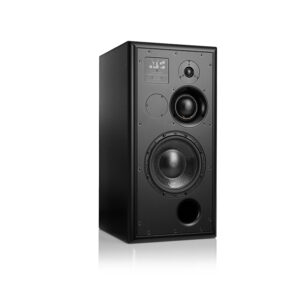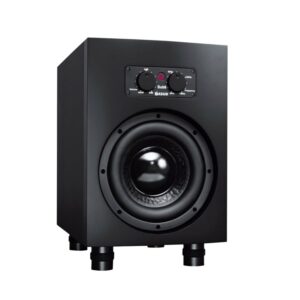Focal Shape 40 Powered Studio Monitor
Professional 4″ nearfield monitor.
$629.00
Description
SHAPE: Beyond the curve
Shape 40 is the most compact studio monitor in the Focal Professional line, and the perfect solution for nearfield monitoring. These monitors can be used from 23″ away (60cm), and they have astonishingly extended low end frequency response. Whether you have a room of less than 107ft2 (10m2), or an installation where compactness is paramount, Shape 40 is the perfect solution.
Features
- MDF cabinet with natural walnut veneer
- 1″ “M”-shaped aluminum/magnesium inverted dome tweeter
- 4″ Flax sandwich cone woofer
- TMD surround
- N. I. C. magnetic circuit
- 4″ double passive radiator
- XLR and RCA inputs
- Releasable high-pass filter
- Adjustable crossover at 160Hz
- Adjustable bass and treble
- Two Class AB amplifiers
Key Points
- Low tweeter directivity for a flexible listening position
- Designed without a port allowing it to be placed near a wall
- Numerous settings for optimal integration
- Accurate control, even in the very high end
- Flax sandwich cone: controlled and articulated bass, natural and detailed lower mid-range and upper mid-range registers. • Threads for ceilling and wall mounts (fastening accessories not supplied)
CABINETS, A QUEST FOR NATURAL MATERIALS…
The monitors in the Shape line immediately distinguish themselves through their unique design. Indeed, the front and top of the MDF cabinets are finished with an authentic, mass-coloured, walnut veneer. The size of the radius on the top of each loudspeaker was calcu- lated specifically for each monitor in order to ensure a linear frequency response in the high end. Echoing the finishes of the Solo6 Be, Twin6 Be and Trio6 Be studio monitors, this natural wood finish is the perfect complement to the new flax cones.
3 NEW WOOFERS, 3 NEW TECHNOLOGIES:
 NEW FLAX SANDWICH CONE
NEW FLAX SANDWICH CONE
Developing speaker driver cone technologies is part of Focal’s core expertise. The Flax sandwich cones used for the woofers on Shape loudspeakers are composed of two materials: glass fibres and flax fibres. A layer of flax fibres is sandwiched between two layers of glass fibres. Glass-fibre cones were also used on the “W” composite sandwich cone of the SM6 and SM9 series, and are revered for their high rigidity considering their light weight.
The soul of the sandwich cone needs to provide good damping while being as light as possible. Flax fibres are twice as light as glass fibres as they’re hollow. What’s more, they also have very low elasticity. This consequently increases the speaker driver’s Young’s mo- dulus when in excursion, an essential property to ensure a piston-like action even in the very low end. Finally, it is 80% composed of cellulose which gives it excellent damping. So, it was only natural for us to choose this material. This new technology has proven to be a considerable improvement over the Polyglass cone in terms of weight, rigidity and damping.
TMD SURROUND
New finite element method simulation tools have enabled us to identify an essential component which could be improved: the surround.
The solution actually came from the world of civil engi- neering and famous skyscrapers, such as Taipei 101. It consists of a steel 660-tonne sphere suspended to a pendulum at the top of the building. It acts as a har- monic absorber to ensure the stability of the building in strong winds.
TMD surround is based on the same principle: to opti- mise harmonic absorption to ensure a piston-like action for the whole audio spectrum reproduced. Thus, two rings have been integrated into the surround. The diameter and location of these rings are determined ac- cording to the flexibility of the surround, its elongation, its resonance frequency and the targeted frequency res- ponse curve of the speaker driver in excursion.
This technology provides a linear frequency response curve between 1 and 2kHz, while significantly reducing distortion in the same range. The mid-range register benefits from remarkable neutrality, and it contributes to the great precision of the overall stereo image.
NEUTRAL INDUCTANCE CIRCUIT
The magnetic field is very difficult to control because it’s modulated by three factors: the movement of the voice coil, the current passing through it, and the frequency. Consequently, the voice coil and the moving part take support on the magnetic field which becomes too “flexible”, and this eventually leads to a loss of precision.
Once again, this is where the recourse to finite element method simulation tools pays off. It made it possible to visualise these complex interactions, and enabled us to come up with an ex- tremely stable magnetic circuit: N.I.C. technology (Neutral Inductance Circuit). This solution consists in a Faraday ring whose dimensions, materials and positioning have been optimised so that the magnetic field is no longer affected by the position of the voice coil, by the amperage or by the frequency of the current passing through it. This also increases frequency response in the high end of the spectrum, thus optimising the crossover with the tweeter, while reducing harmonic distortion and intermodulation.
NEW “M”-SHAPED ALUMINUM-MAGNESIUM INVERTED DOME TWEETER
Focal has further improved its famous aluminium- magnesium inverted dome tweeter by coming up with two considerable mechanical innovations: the new “M”- shaped dome and a dedicated surround, like that used on the tweeters in the SM6 and SM9 lines.
The inverted “M”-shaped dome has two major advan- tages. Its directivity is even less that of the inverted dome tweeter, allowing for more flexibility in terms of listening position. Mechanically speaking, the “M” shape gives the dome much more rigidity, while redu- cing distortion even more. In addition to this, the Poron® surround allows for a more linear frequency response curve below 6kHz, optimising the crossover with the woofer. The magnetic component has also been op- timised thanks to a voice coil with a Kapton® former which significantly reduces the Foucault current, and consequently, distortion. Finally, the horn housing the tweeter has been designed to provide equal horizontal and vertical directivity.
The double passive radiator on Shape monitors is an ingenuous solution to a common issue encountered with nearfield monitors: to combine a compact design, extended frequency response in the low end and a posi- tioning which is comfortable.
Indeed, when ported systems meet their limits in terms of integration (a long-enough port to match its surface is required), the passive radiator becomes the ideal solution. However, rocking modes can often occur de- pending on the frequency and the volume. In order to compensate for this phenomenon, two U-shaped sur- rounds positioned opposite each other join the passive disk to the basket, ensuring perfect symmetry during excursion and incursion. Finally, the very low tuning frequency allows the monitors to be placed very close to a wall.
ELECTRONICS AND SETTINGS
Class AB amplification was the obvious choice for Shape monitoring loudspeakers in order to provide optimal control over the audio signal’s dynamic range. Each speaker driver is equipped with its own amplifier, pro- viding stable tonal balance, regardless of the volume. As for the settings, particular attention has been paid to integration, regardless of the room’s acoustics. Each monitor features a shelving filter for high and low frequencies (HF: +/- 3dB from 4.5kHz; LF +/- 6dB above 250Hz). A crossover at 160Hz (+/-3dB) allows you to correct any parasite reflections due to an installation on a mixing console or near a reverberating surface. Finally, each loudspeaker is equipped with an adjustable high-pass filter to solve any issues due to rooms which present sporadic behaviour in the low end, but also for the crossover with a subwoofer if one is used.
ACCESSORIES AND INSTALLATION
Shape monitoring loudspeakers come with 4 adjus- table decoupling spikes. The height of the front and rear spikes can be adjusted to solve any problems which sometimes occur due to the loudspeakers not being at the same height as the listener. The angle changes the height of the soundstage to best suit the height of the sound engineer. Finally, a clever finishing touch to the spikes is their rubber coating. This improves isolation of the loudspeakers in relation to their support.
Also, each monitor is supplied with two protective grilles for the woofer and tweeter. Particular attention has been paid to efficiency, and the design enables the grilles to be removed or assembled without needing any tools.
Finally, we haven’t forgotten the diversity of listening environments and set-ups. Indeed, Shape loudspeakers are equipped with fastening mechanisms on the back and underneath, so that they can be installed on the wall or on the ceiling. The two most compact monitors, Shape 40 and 50, also have a fastening mechanism on the underneath so that they can be installed on a table stand or a microphone stand.
Related products
-
ATC P1 Pro Dual-Mono Power Amplifier
$3,999.00Add to WishlistAlready In WishlistAdd to Wishlist-
Add to cart -
ATC SCM50A Pro – Pair
$17,490.00Add to WishlistAlready In WishlistAdd to Wishlist-
Add to cart -
ATC SCM150A Pro 3-Way Midfield Monitor – Pair
$22,990.00Add to WishlistAlready In WishlistAdd to Wishlist-
Add to cart -
Adam Audio Sub8 Subwoofer
$899.99Add to WishlistAlready In WishlistAdd to Wishlist-
Add to cart










